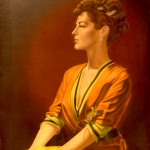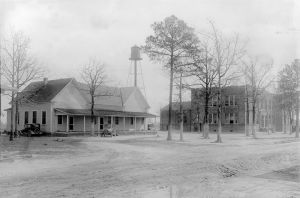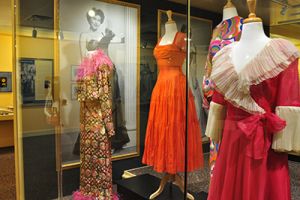The Ava Gardner Museum: The Jewel of Johnston County
I didn’t know what to expect the first time I visited the Ava Gardner Museum in Smithfield, North Carolina. I had moved to North Carolina from the West Coast only a week before but I knew who Ava Gardner was and I was intrigued that she had been born and raised in rural North Carolina. My grandfather talked about her as his favorite actress and pinup during his pilot days in World War II. I was just sure that the museum would not be much more than a bunch of movie posters hanging on a wall and maybe a costume or two that they had managed to get their hands on. I was unprepared for the hidden jewel I was about to discover.
When you first approach Johnston County, you might take in the large expanse of tobacco fields and hog farms and think it has some scenic pastoral beauty. The word glamorous might elude you unless you were already familiar with its most famous resident Cinderella. In 1941, a small-town North Carolina girl named Ava Gardner ventured into Hollywood. By 1946, she was a breakout success and her name would become synonymous with the sultry glamour of Golden Age Hollywood. Two failed marriages with some of the biggest names in entertainment preceded her initial career success, and at the height of her career she would become embroiled in a shocking scandal for her romance with and eventual marriage to the most famous crooner of all time, Frank Sinatra. Their legendary passion lasted on and off until her death in January 1990 and the notoriety caused by their romance never escaped Ava. She eventually would relocate to Spain and finally to London in order to gain privacy, but she always came home to where her roots were in Smithfield.
- Ava Gardner in The Barefoot Contessa (1954) Courtesy of The Ava Gardner Trust.
- Ava Gardner in The Killers (1946). Courtesy of The Ava Gardner Trust.
- Ava Gardner on her Grabtown home porch. Courtesy of The Ava Gardner Trust.
- Ava Gardner in One Touch of Venus (1948). Courtesy of The Ava Gardner Trust.
- Ava Gardner news portrait. Courtesy of The Ava Gardner Trust.
- Ava Gardner by artist Albrecht Pfeiffer. Courtesy of The Ava Gardner Trust.
Ava Gardner is still listed as the twenty-fifth most popular actress of all time by the American Film Institute, and she continues to have fans all over the world. For casual and dedicated fans alike, Smithfield has become a mecca for Ava Gardner cinephiles. Certainly the most famous person to emerge from the Smithfield area and perhaps all of North Carolina, Gardner is a point of pride for the local community, who nearly all claim some tie or another to her. Not only is the Ava Gardner Museum located in the county seat, but her homestead, the Heritage Trail of significant sites, and even her gravesite are within short driving distance. Yet, as the years pass, a few questions are repeated: How can you keep Ava Gardner relevant to modern audiences? What makes people want to visit? How long will the museum be sustainable? In order to understand the vision of the Ava Gardner Museum, it is important to understand its history and the progress it has made since it first opened its doors in the 1980s.
The museum had the most humble of origins: it was the brainchild of a young Wilson boy named Tom Banks, who never quite got over the enchantment of a quick smooch Ava had given him in jest during her college days at Atlantic Christian College (now Barton College). As a result he accumulated memorabilia over his lifetime, through an apprenticeship on one of Ava’s films, and even a friendship (mostly through writing) with Ava herself. Dr. Tom Banks eventually moved to Florida and married his wife Lorraine, who helped manage his collection. In 1979, Dr. Banks took his collection on a small traveling exhibit to Smithfield for three days. The community seemed receptive to the artifacts. At one point, Dr. Banks considered leaving the vast collection to a large university. Although, it is said that Ava told him that if a museum dedicated to her belonged anywhere, it belonged in her hometown. Dr. Banks purchased one of Ava’s local childhood homes, the Brogden Teacherage, located just outside Smithfield in 1981. The Teacherage was a little more than structure and facade due to a fire and required a serious amount of remodeling. Doris Rollins Cannon, the editor of the local newspaper, the Smithfield Herald, and a museum volunteer who collaborated with the Banks to open the museum, explains in her book Grabtown Girl: Ava Gardner’s North Carolina Childhood and Her Enduring Ties to Home that the museum was not in an ideal location and people would spend hours in the countryside trying to find it. At the time, and because it was run by volunteers, the museum was only open seasonally and for limited hours. Cannon relates how one evening in 1985 Ava and her sisters attempted to visit the museum. When they found it locked, someone suggested they call a volunteer to come open it. Ava declined, saying that she knew what was in there because she had lived it.
Unfortunately, Tom Banks died unexpectedly in 1989. A year later, Lorraine donated the collection to the Town of Smithfield on the condition that they would always provide a home for it. It went on display in 1991 at a South Third Street location in downtown Smithfield. According to various Board members, the building was not an ideal place and was a curator’s absolute nightmare. Testimonials described it as an “attic” with leaky roofs, silverfish, and moths, and to my abject horror, people were even allowed to try on some of Ava’s clothing! Another disaster caused the building to be uninhabitable and the collection took temporary refuge in a church building down the street. In 1996, the museum was incorporated as a 501(c)(3) nonprofit organization and various fundraising campaigns took place to help the museum find a permanent home.
In 2000, the collection moved to its permanent and current location. The hundred-year-old building has been upgraded and retrofitted into a gallery-style setup, complete with exhibit cases, a library, and even a theater that can seat up to fifty people. The space consists of 6,500 square feet, and the archive holds an estimated 150,000 different artifacts. The museum continues to upgrade as finances permit and is dependent on visitation, purchases, grants, donations, and the generosity of Ava advocates. The museum’s artifact collections hold a staggering amount of photographs, films, paintings and sketches, correspondence, sculpture, clothing and accessories, household items, and even some bric-a-brac. Of course, one of the most unique things about the museum is its collection of Albrecht Pfeiffer paintings, three of which hung in Ava’s London apartment until her death. Pfeiffer was a Dutch artist who fell in love with Ava after seeing her in One Touch of Venus in 1948. Every year from then on, he painted a different portrait of Ava. He adored her, and his paintings are widely regarded as the most well done of Ava ever. Many of them feature whimsical touches, such as a mouse running up her arm, a table with no legs, and even Pfeiffer’s photo in a locket she is holding in the portrait. Although they do not exist in every painting, these “Easter eggs” are a fan favorite for guests who enjoy trying to identify them in a Where’s Waldo? fashion. Sadly, Pfeiffer never got the chance to meet his adored Ava, but after his death, his estate willed the remainder of his Ava paintings to the museum according to his wishes. These paintings are rotated periodically to ensure that return visitors see something new every time they visit.
Film star museums have a notorious reputation for being just a room full of old movie posters and tacky mementos of the bygone era of greatness in Hollywood. The most frequent comments we get from visitors are their astonishment at how well done the museum showcase is and the diversity of artifacts we have on display. Moreover, they are surprised about Ava’s connections to other stars such as Lena Horne, Princess Grace of Monaco, and of course the love of Ava’s life, Frank Sinatra. A short film educates guests before they walk through the remainder of the museum on a self-guided tour, ending in the library where Ava’s personal books and many of the Pfeiffer paintings are hanging. A new exhibit premieres every October, which is also the anniversary of the museum’s opening at the current location in 2000. Past exhibits have included loans from Debbie Reynolds for a Show Boat and Mogambo exhibit. Other exhibits have included artifacts related to Ava’s friendships with Lena Horne and Gregory Peck. The current exhibit is called “Ava’s Closet” and features the largest collection of Ava’s personal clothing and accessories ever put on display. The main case houses evening wear, day wear, and intimate wear. The most stunning showpiece is a unique pink and white tiara that Ava wore to many formal occasions and was recently donated to the museum by Ava’s friend and personal assistant, Carmen Vargas. The museum relies on the generosity of family, friends, and collectors of Ava’s belongings in order to add more artifacts to the collection. Some items have been purchased from private collectors and auctions; however, the museum’s resources as a non-profit museum often make those ventures cost prohibitive.
Ava was once regarded as one of the most famous women in the world and was dubbed “the world’s most beautiful animal” after the tagline from her film The Barefoot Contessa (1954). People often associate her with her three famous husbands: Mickey Rooney, Artie Shaw, and Frank Sinatra. Her close friendships with Hollywood greats like John Huston, Gregory Peck, Lena Horne, Lana Turner, Howard Hughes, and many others are also points of interest for many visitors. Her hometown roots can be explored further by picking up a copy of the Ava Gardner Heritage Trail and visiting places in the community that were significant in Ava’s life. Ava is laid to rest in the cemetery just one mile down the street from the museum. What is left of her legacy is proudly displayed at the museum under neon lights where some people are lucky to meet members of her family and hear personal stories not written in any books. While some people wonder how a museum can keep a vintage film star relevant to modern audiences, the museum is proof that Ava is still doing pretty well for herself thanks to retro-nostalgia, cinematic studies, and the fact that some things just never go out of style. Tom and Lorraine Banks had a vision of honoring Ava and her accomplishments and together with the help of Doris Cannon and many other volunteers, their love and admiration for Ava Gardner is what makes this museum truly unique and unparalleled. The evolution of the museum’s mission continues to be a remarkable one.
If you are looking for a unique experience, come visit downtown Smithfield and drop in to meet Ava at the museum where we celebrate the life, loves, and legacy of one of Hollywood’s most famous leading ladies and the pride of North Carolina. The museum is located is just one mile directly off US Interstate 95. You can follow us on Facebook, Twitter, and our blog. You can also find out more at www.avagardner.org.
















I am really glad to hear that a museum exist’s for Ava. She is without a doubt one of Hollywood’s most beautiful and sexy stars.
I visited the museum with a friend, because of her ties to Frank Sinatra ….. didn’t know what to expect, and it was impressive. A fantastic tribute to a huge star from the Smithfield area. Many things to look at, in a beautiful building.
Iam so Happy and most amazed for this very talented beautiful creature God has ever brought to life.